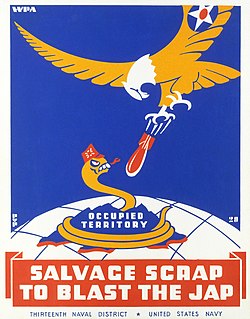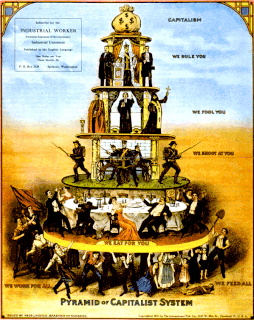
Advertising is a marketing communication that employs an openly sponsored, non-personal message to promote or sell a product, service or idea. Sponsors of advertising are typically businesses wishing to promote their products or services. Advertising is differentiated from public relations in that an advertiser pays for and has control over the message. It differs from personal selling in that the message is non-personal, i.e., not directed to a particular individual. Advertising is communicated through various mass media, including traditional media such as newspapers, magazines, television, radio, outdoor advertising or direct mail; and new media such as search results, blogs, social media, websites or text messages. The actual presentation of the message in a medium is referred to as an advertisement: advert or ad for short.

Propaganda is communication that is primarily used to influence an audience and further an agenda, which may not be objective and may be selectively presenting facts to encourage a particular synthesis or perception, or using loaded language to produce an emotional rather than a rational response to the information that is being presented. Propaganda can be found in news and journalism, government, advertising, entertainment, education, and activism and is often associated with material which is prepared by governments as part of war efforts, political campaigns, health campaigns, revolutionaries, big businesses, ultra-religious organizations, the media, and certain individuals such as soapboxers.

A slogan is a memorable motto or phrase used in a clan, political, commercial, religious, and other context as a repetitive expression of an idea or purpose, with the goal of persuading members of the public or a more defined target group. The Oxford Dictionary of English defines a slogan as "a short and striking or memorable phrase used in advertising." A slogan usually has the attributes of being memorable, very concise and appealing to the audience.

Media manipulation is a series of related techniques in which partisans create an image or argument that favours their particular interests. Such tactics may include the use of logical fallacies, manipulation, outright deception (disinformation), rhetorical and propaganda techniques, and often involve the suppression of information or points of view by crowding them out, by inducing other people or groups of people to stop listening to certain arguments, or by simply diverting attention elsewhere. In Propaganda: The Formation of Men's Attitudes, Jacques Ellul writes that public opinion can only express itself through channels which are provided by the mass media of communication – without which there could be no propaganda. It is used within public relations, propaganda, marketing, etc. While the objective for each context is quite different, the broad techniques are often similar.
A public service announcement (PSA) is a message in the public interest disseminated by the media without charge to raise public awareness and change behavior. In the UK, they are generally called 'public information films' (PIFs); in Hong Kong, they are known as 'announcements in the public interest' ('APIs').
Mass marketing is a marketing strategy in which a firm decides to ignore market segment differences and appeal the whole market with one offer or one strategy, which supports the idea of broadcasting a message that will reach the largest number of people possible. Traditionally, mass marketing has focused on radio, television and newspapers as the media used to reach this broad audience. By reaching the largest audience possible, exposure to the product is maximized, and in theory this would directly correlate with a larger number of sales or buys into the product.

Direct marketing is a form of communicating an offer, where organizations communicate directly to a pre-selected customer and supply a method for a direct response. Among practitioners, it is also known as direct response marketing. By contrast, advertising is of a mass-message nature.
Marketing Communications refers to the use of different marketing channels and tools in combination. Marketing communication channels focus on any way a business communicates a message to its desired market, or the market in general. Marketing communication tools include advertising, personal selling, direct marketing, sponsorship, communication, public relations, social media and promotion.

The Advertising Council, commonly known as the Ad Council, is an American nonprofit organization that produces, distributes, and promotes public service announcements on behalf of various sponsors, including nonprofit organizations, non-governmental organizations and agencies of the United States government.
Copywriting is the act or occupation of writing text for the purpose of advertising or other forms of marketing. The product, called copy or sales copy, is written content that aims to increase brand awareness and ultimately persuade a person or group to take a particular action.

Advertising management is a planned managerial process designed to oversee and control the various advertising activities involved in a program to communicate with a firm's target market and which is ultimately designed to influence the consumer's purchase decisions. Advertising is just one element in a company's promotional mix and as such, must be integrated with the overall marketing communications program. Advertising is, however, the most expensive of all the promotional elements and therefore must be managed with care and accountability. Advertising management process also helps in defining the outline of the media campaign and in deciding which type of advertising would be used before the launch of a product.

An advertising campaign is a series of advertisement messages that share a single idea and theme which make up an integrated marketing communication (IMC). An IMC is a platform in which a group of people can group their ideas, beliefs, and concepts into one large media base. Advertising campaigns utilize diverse media channels over a particular time frame and target identified audiences.

Media has a fundamental role in deciding what is important for recipients (topics); who is to talk about this and in what context certain matters should be discussed. In politics, campaign advertising is the use of an advertising campaign through the media to influence a political debate, and ultimately, voters. These ads are designed by political consultants and political campaign staff. Many countries restrict the use of broadcast media to broadcast political messaging. In the European Union, many countries do not permit paid-for TV or radio advertising for fear that wealthy groups will gain control of airtime, making fair play impossible and distorting the political debate in the process.
Interactive advertising uses online or offline interactive media to communicate with consumers and to promote products, brands, services, and public service announcements, corporate or political groups.
Advertising Council Japan, formerly named Japan Advertising Council until June 30, 2009, is a private non-profit organization that distributes Japanese public service announcements on behalf of various sponsors, including both non-profit organizations and government agencies.

Propaganda in the United States is spread by both government and media entities. Propaganda is carefully curated information, ideas, or rumors deliberately spread, usually to preserve the self-interest of a nation. It is used in advertising, radio, newspaper, posters, books, television and other media. Propagandists may provide either factual or non-factual information to their audiences, often emphasizing positive features and downplaying negative ones, or vice versa, in order to shape wide scale public opinion or influence behavioral changes.

Advertising media selection is the process of choosing the most efficient media for an advertising campaign. To evaluate media efficiency, planners consider a range of factors including: the required coverage and number of exposures in a target audience; the relative cost of the media advertising and the media environment. Media planning may also involve buying media space. Media planners require an intricate understanding of the strengths and weaknesses of each of the main media options. The media industry is dynamic - new advertising media options are constantly emerging. Digital and social media are changing the way that consumers use media and are also influencing how consumers acquire product information.
Sustainability advertising is communications geared towards promoting social, economic and environmental benefits (sustainability) of products, services or actions through paid advertising in media in order to encourage responsible behavior of consumers.

A number of propaganda techniques based on social psychological research are used to generate propaganda. Many of these same techniques can be classified as logical fallacies, since propagandists use arguments that, while sometimes convincing, are not necessarily valid.

Brandalism is an anti-advertising movement. It is a form of creative activism that uses subvertising to alter and critique corporate advertising by creating parodies or spoofs to replace ads in public areas. The art is typically intended to draw attention to political and social issues such as consumerism and the environment. Advertisements produced by the Brandalism movement are silk screen printed artworks, and may take the form of a new image, or a satirical alteration to an existing image, icon or logo. The advertisements are often pasted over billboards, or propped under the glass of roadside advertising spaces.












